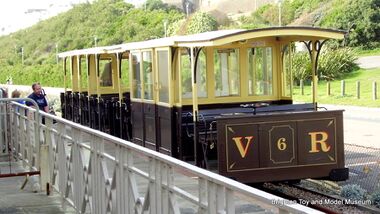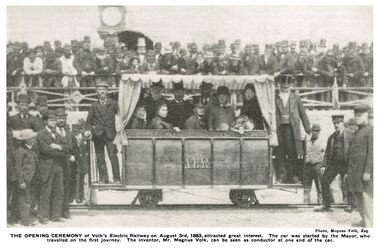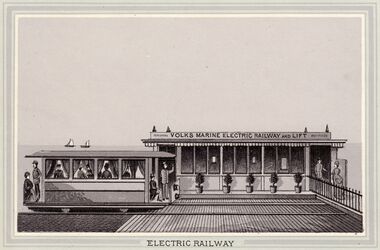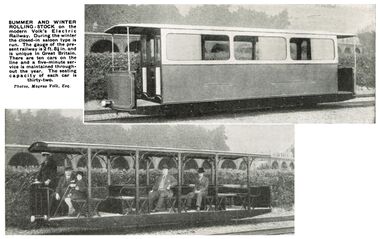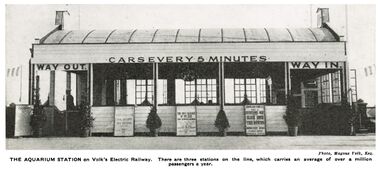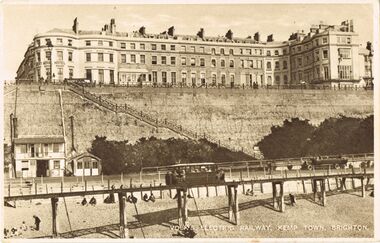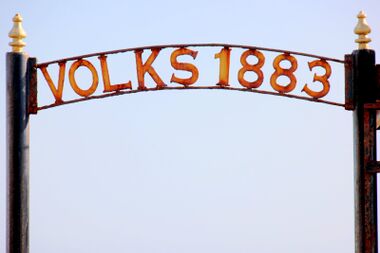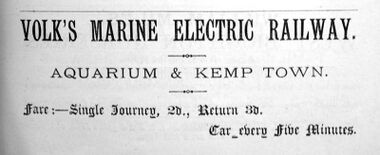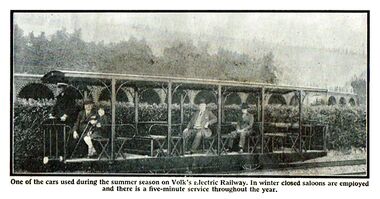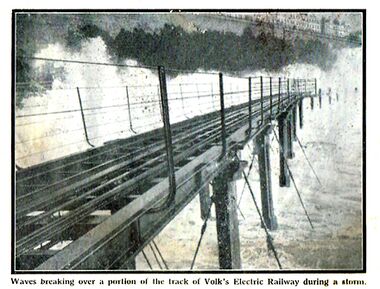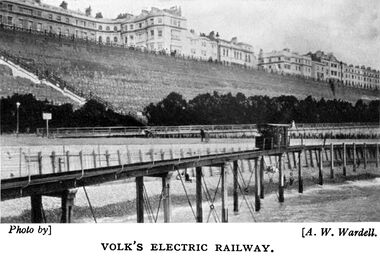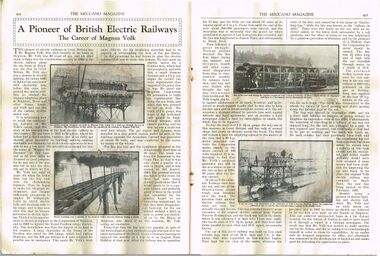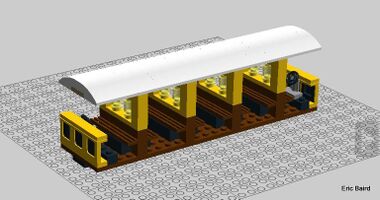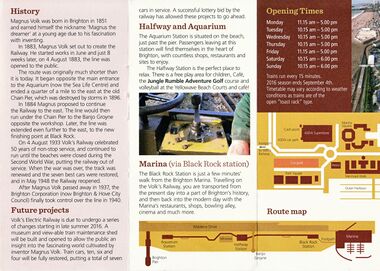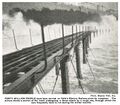Category:Volks Electric Railway
Volks Electric Railway Car No.6, at Black Rock station [image info]
1883: "THE OPENING CEREMONY of Volk's Electric Railway on August 3rd, 1883, attracted great interest. The car was started by the Mayor, who travelled on the first journey. The inventor, Mr Magnus Volk, can be seen as conductor at one end of the car." Magnus Volk is on the left side of the coach, the gentleman in the top hat on the right is presumably Mayor Arthur Cox [image info]
1888: Engraving showing a carriage and terminus station for the "Volks Marine Electric Railway" [image info]
1935: "SUMMER AND WINTER ROLLING-STOCK on the modern Volk's Electric Railway. During the winter the closed-in saloon type is run. The gauge of the current railway is 2 ft 8½ in., and is unique in Great Britain. There are ten cars on the line, and a five-minute service is maintained throughout the year. The seating capacity of each car is thirty-two." [image info]
1935: "THE AQUARIUM STATION on Volk's Electric Railway. There are three stations on the line, which carries a average of over a million passengers a year." [image info]
The Railway and the Court Royal Hotel, Kemp Town [image info]
1883: VER signage above passenger entrance [image info]
1885: Volks Marine Electric Railway, ticket details [image info]
Volk's Electric Railway summer carriage in front of Brighton Promenade, Meccano Magazine 1937 [image info]
Waves breaking over the elevated and exposed Volk's Electric Railway track during a storm, Meccano Magazine 1937. Beach defences have since raised the height of the beach to match the height of the track. [image info]
1933: View looking Northeastish from the Banjo Groyne. Eastern Terrace is visible above the sea wall [image info]
Volks Electric Railway pedestrian crossing sign [image info]
Magnus Volk, the Volks Electric Railway, and the Daddy-Long-Legs (Meccano Magazine, 1937) [image info]
Model of a VER carriage (Lego Digital Designer) [image info]
2016 official leaflet [image info]
2016 official leaflet [image info]
The Volks Electric Railway runs along part of Brighton seafront, and was opened in 1883. It is the World's oldest commercial electric passenger railway.
History
The railway was the brainchild of Brighton-based inventor Magnus Volk. It opened in August 1883, and originally ran between the Brighton Aquarium and the Chain Pier. It was later extended to the Banjo Groyne, and then further, to Black Rock Station (which is linked to Brighton Marina by a footpath).
The Railway was taken over by the Brighton Corporation in 1940, a couple of years after Volk's demise.
Then and Now
Riding on the Volks was originally a much more hair-raising experience, as the beach level was far lower, and the railway only managed to run at Promenade level thanks to a system of wooden bridgework that allowed it to run high above the beach, rather like a rollercoaster (except that the railway tended to run level ... except where it ducked underneath the Chain Pier).
Old photographs show the railway to be a rather alarming construction, with riders at high tide liable to be subjected to waves crashing into the Promenade wall below the railway track and dousing the carriages with spray.
When Brighton's beach defences were put in place, the beach level rose until it created the current "pebbly" beach whose top is practically level with the railway track. This tends to make it look as if the Volks Electric Railway was simply run along the beach, but the elaborate bridgework that originally supported the railways is still in place, buried beneath the pebbles.
1884 notes:
* For operating the mile long electrical railroad on the Madeira road, at Brighton, England, the machinery, which is situated at the eastern extremity of the line, consists of an 8 horse-power Otto engine and a Siemens “D” dynamo-electric machine. Two cars can be propelled at the rate of thirty miles an hour, but the speed is restricted to seven miles.
— , -, , Electrical Review, , 21st June 1884
1885 controversy:
The Electric Railway at Brighton. — A lengthy discussion took place at the last meeting of the Brighton Town Council with reference to Mr. Volk’s electric railway. A motion was introduced by Councillor Daniel to the effect that an instruction should be given to Mr. Volk to remove and clear away by the 30th of September next so much of his electric railway as lies between the Old Pier and Paston Place. He argued that owing to the railway, Madeira Road, which had previously been thronged with visitors, was now almost deserted, and he said that Mr. Volk had partially destroyed the beautiful gradient that was made at Kemp Town. The railway was a constant source of danger, as it frightened horses, and he would rather that they compensated Mr. Volk against any loss than that matters should remain as they at present were. The road having been destroyed by the action of the railway, he thought it was the duty of the Council to have it removed, Councillor Berry seconded the resolution. Several members stated that no danger had hitherto arisen from the railway, which was a valuable attraction. Councillor Hall moved an amendment to the effect that the Works Committee should be requested to bring up a special report on the subject, and if it was resolved to continue the railway, suggest the terms that should be charged for the site. Councillor Dr. Ewart, who seconded, described the railway as an “unmitigated blessing.” Alderman Lamb said that after the short piece of line was tried as an experiment the Council thought it should be extended and turned into something useful, and consequently Mr. Volk extended it. That it had proved useful was shown by the fact that in twelve months 250,000 people had travelled upon it. Mr. Volk had laid out £3,500 on the railway. Petitions in favour of the railway had been signed by 6,000 people, and he believed nine-tenths of the people in the East-end of Brighton would be in favour of its continuance. After further discussion, the amendment was carried by 34 to 10.
— , -, , The Telegraphic Journal and Electrical Review, , 30th May 1885
1933 description:
On leaving the Aquarium we can avail ourselves of –
Volk's Electric Railway
To take a run eastward and see something of the Madeira Drive and the Marine Parade above it. The railway is a modest little line running along the beach from the Palace Pier gates to the Black Rock, with an intermediate station at Paston Place. The cars hold from thirty to forty passengers and run every five minutes. The ride is very pleasant, as the cars command an excellent view seaward all the way.
— , Ward Locke, , Brighton, Hove & District, , 1933
1935 description:
Brighton's Electric Railway: The First Electric Line in Great Britain
ON August 3, 1883, the first public electric railway in England began to run. This was a line, about a quarter of a mile long, which extended along the sea front at Brighton, from the Aquarium to the Old Chain Pier. Fifty-eight years had elapsed since the opening of the Stockton and Darlington Railway in 1825, and hitherto the supremacy of steam had remained unchallenged; but that August day saw the first practicable application to railways of one of steam's most formidable rivals. Volk's Electric Railway is thus not only interesting in itself, but is also of considerable importance in the history of British railways.
That it was some years in advance of its time is shown by the fact that it antedated the City and South London Railway, the world's oldest tube railway, by about seven years.
The undertaking was the idea of Mr. Magnus Volk, who has remained associated with it for over fifty years. Mr. Volk's interests included pioneer work in connexion with the electric telegraph, the telephone, electric lighting, and electrically-propelled motor cars. But he is perhaps best remembered for his promotion of Volk's Electric Railway. Mr. Volk, who was Electrical Engineer to the Brighton Corporation, was responsible also for the Brighton and Rottingdean Extension, an electric line which ran through the sea at high tide. Both these lines will be described in this chapter.
The Volk's Electric Railway has carried over forty million people since its inception. In its present extended form it runs along the sea front near the Palace Pier to Black Rock, a distance of about one and a half miles. The track is slightly elevated above the beach, and at high tide it runs over the sea – a feature that gives point to the claim that it is "the only railway of its kind in England". There are three stations, each of which exhibits placards drawing attention to the unique character of the line.
The official opening day was August 3, 1883. During August Bank Holiday of that year, when the line was in operation for eleven hours, the single car in its possession is said to have carried about a thousand passengers and to have run an aggregate of fifty miles. As originally constructed, the gauge of the railway was only two feet. The small four-wheeled car was driven by current generated from a two horsepower gas engine, and ran at a service speed of six miles an hour.
Despite gloomy predictions as to its impracticability, the railway was a popular success from the first. The announcement of the opening of Volk's Electric Railway attracted large crowds of spectators, the more especially as it was expected that the car would not work. In this the crowd was disappointed, as when started by the Mayor, the car with a heavy load moved away easily and without a hitch.
Permission for the operation of the line had originally been granted for only six months, but this period was speedily extended. In the meantime the success of the undertaking had given rise to much local antagonism, especially on the part of the cabmen, boatmen, and persons engaged in the hay and corn-chandlering trades. Sleepers, signboards and other equipment began to develop the habit of disappearing overnight. Nature also took a hand; a series of violent storms wrecked the line four times in a single summer. Although the damage was at once repaired in every instance, the work added greatly to the cost of running the system. Mr. Volk's plucky fight, however, brought him both sympathy and offers of financial support, including the opening of a subscription list by a local newspaper that produced sufficient funds for the repair of the whole line. Thus Mr. Volk was enabled to keep the line open and to remain its owner, instead of abandoning it or handing it over to a company or public authority.
The original permanent way was composed of flat-bottomed rails weighing twenty pounds to the yard, and spiked to longitudinal sleepers. These measured ten feet by nine inches by three inches, and were coated with tar. Shingle was used as packing. The gas engine that furnished the power was set up in an arch under the roadway opposite the Aquarium, developed nearly three horsepower in working, and drove a self-regulating generator giving current at fifty volts. A machine of similar size, but with magnets and an armature arranged in series, was installed in the car as a motor.
From its earliest days, the railway attracted considerable attention in the press. A contemporary account refers to "the electric car, which (so Mr. Volk informs us) is a model of the interior of the deck saloon on a steam yacht; constructed of solid mahogany, plate-glass windows, a panelled ceiling with paintings of flowers and palms; blue silk curtains to the windows, mirrors, and so on. The exterior is precisely that of a first-class railway carriage,, with the exception that the footboards are protected by brass rails."
This description is not that of the first vehicle, which, as will be seen from the illustration on page 608, was hardly of so ornate a character. That was, however, scarcely to be expected, since the car, together with the dynamo and motor, was built, the generating plant installed, and the track laid, within eighteen days. This period must be regarded as remarkably short, when the pioneer nature of the whole work is borne in mind.
Despite the opposition of interested parties who feared competition, the Brighton Corporation – very soon after the opening – gave permission for an extension from the Aquarium to Paston Place. This was speedily followed by a further extension to the existing terminus at Black Rock. Between August, 1883, and the beginning of the following January, a total of about 300,000 passengers had been carried, and the volume of traffic showed that the railway, even in its short initial form, had definitely filled a public need.
In its present form the line, which is mostly single track, though equipped with adequate passing places, is laid on the 2 ft. 8½ in. gauge, being the only line in the kingdom constructed to that dimension.
The longitudinal sleepers have given place to the more customary cross sleepers, the running rails are of the Vignolles pattern, and the conductor third rail of channel section steel on earthenware insulators.
The original little vehicle has been replaced by a total of ten cars, some closed and some open. The latter are known as "toast racks", a design that greatly facilitates quick entrance and exit. The seating capacity of each car is thirty-two, but, since strap-hanging is allowed, as many as fifty people can be accommodated in a vehicle.
In spite of the small size of the undertaking, the line carries an average of well over a million passengers a year. It is a point of pride with the management that the five-minute service, which is maintained throughout the twelve months, has been operated for nearly fifty years. Moreover, although the purpose of the railway is primarily to cater for holiday-makers, it has also proved itself to be a valuable addition to the general traffic facilities of Brighton and Kemp Town.
The generating plant has officially been described as being situated "in a cave in the sea wall". The main equipment consists of a 90 h.p. motor generator converting the Corporation electric supply of 460 volts direct current to the track voltage of 160. There is also a small reserve 20 h.p. set. Two types of motor are in use, three cars being of the original Siemens link belt-drive type, and the rest of modern tramway pattern, with single reduction gear, and generating from 7 to 8 h.p. at 750 revolutions a minute. All the transmission gear is fitted with either ball or roller bearings. The original generator was still in use as a motor in one of the cars as late as 1934.
— , -, , Brighton's Electric Railway: The First Electric Line in Great Britain, , Railway Wonders of the World, , 1935
1942 overview:
Magnus Volk and his Railways
By CHARLES E LEE:
ELECTRIC traction has for so long been a part of our daily life that it is difficult to realise that the practical history of electric traction is spanned by the life of one man. Magnus Volk was born in Brighton on October 19, 1851, at a time when the tractive force of electricity was envisaged only in the form of the experimental battery vehicle. The first electric railway in the world was a 900-yd. exhibition line laid in Berlin in 1879 by Dr. Werner von Siemens, and the first public line was opened in May, 1881, at Lichterfelde, a suburb of Berlin. Progress during the next two years was not rapid, and when in 1883 Volk proposed to build an electric line on the beach at Brighton, he was in the true sense, a pioneer. He had already obtained a gold medal in 1881 for a street fire-alarm system similar to that still in use, and in the next year he had introduced the telephone to Brighton. He then became Electrical Engineer to the Brighton Corporation, and in April, 1883, lighted the whole of the Brighton Pavilion, an installation which was then the largest in the country.
It was at this time that he secured the consent of the Corporation to lay an electric railway along the beach from a point opposite the entrance of the old Aquarium to the Chain Pier. This was opened on August 3, 1883, by the Mayor of Brighton, and was the first in Great Britain. When the jubilee was celebrated, more than eight years ago, the many telegrams of congratulation included a graceful tribute to Mr. Volk from Mr. Gilbert S. Szlumper, then Assistant General Manager of the Southern Railway, which read, "Your pioneer electric service set example which we have seized upon." This original line was worked for about six months, during which some 30,000 persons were carried. At first the running rails spiked to longitudinal tar-coated wooden sleepers) were used as conductors, and the car had wooden wheels with steel tyres; the original gauge is believed to have been 2 ft. In the early months of 1884 the line was reconstructed and extended under the Chain Pier to Paston Place, and was reopened on April 4. The present gauge of 2 ft. 8 in. was then adopted, and a third-rail conductor installed. Financially it proved a great success from the beginning, and some 30,000,000 passengers have been carried to date.
Probably Volk's most ambitious traction project was a scheme sanctioned by Parliament in 1893 under the formidable title of the Brighton & Rottingdean Seashore Electric Tramroad Company, which materialised under the popular appellation of "Daddy Long-Legs." This was a 40-ton saloon car, 50 ft. by 22 ft., which accommodated 150 passengers on a deck supported 24 ft. above rails on four steel legs. The feet enclosed four 30-in, wheels, so that the car ran on sixteen wheels. The track consisted of two pairs of 2 ft. 8½ in. gauge lines laid so that the extreme rails were 18 ft. apart. Power was conveyed by an overhead trolley-wire to four 25-h.p. electric motors on deck, and was transmitted thence by shafts inside the legs. This line was opened in November, 1896; badly damaged by the great gale of December of that year, which swept away the famous old Chain Pier; resumed work in August, 1897; and was removed in 1901 to allow for groyne lengthening by Brighton Corporation. An extension to Black Rock of the original Volk line was made in part substitution, and opened on February 21, 1901. Magnus Volk died on May 20, 1937, in his 86th year. The tenancy of the Brighton Electric Railway was terminated by Brighton Corporation, and the line has been operated by the Brighton Corporation Transport Department since April 1, 1940. Its present rolling stock is 10 electric cars, which normally maintain a frequent service on the 1¼ existing miles of line.
— , Charles E. Lee, , Magnus Volk and his Railways, , The Railway Magazine, , 1942
2011 Running Times
Since the Volks Electric Railway uses comparatively "open" carriages (and is exposed to the seafront), the railway shuts down during the Winter months, and its schedule is liable to disruption when weather is inclement.
By default, trains run four times an hour.
| Days | Running Times |
|---|---|
| Mondays, Wednesdays, Thursdays | 10:15 - 17:00 |
| Tuesdays, Fridays | 11:15 - 17:00 |
| Saturdays, Sundays | 10:15 - 16:00 |
The last day of 2011's running season is 30 September 2011.
Exhibits
Leaflets about the Volks Railway are available from the Museum's brochure racks.
See also
- Volks Electric Railway (model carriage)
- Brighton to Rottingdean Seashore Electric Railway
- Magnus Volk
Further Information
Further information of the Volks Electric Railway is given in the organisation's free booklet (available from the Museum's Visitor Information Point), or online.
|
i360 – West Pier – Palace Pier – Chain Pier – Volks Railway – Daddy Long-Legs – Brighton Marina |
Subcategories
This category has the following 4 subcategories, out of 4 total.
Pages in category ‘Volks Electric Railway’
The following 4 pages are in this category, out of 4 total.
Media in category ‘Volks Electric Railway’
The following 38 files are in this category, out of 38 total.
- Aquarium Station, Volks Electric Railway (RWW 1935).jpg 2,200 × 977; 1.5 MB
- Black Rock (BHAD10ed 1933).jpg 2,200 × 1,453; 1.66 MB
- Black Rock Station and Marina (Brighton 2014).jpg 2,000 × 1,144; 1.59 MB
- Black Rock terminus, Volks Electric Railway.jpg 1,200 × 900; 948 KB
- Brighton Beach from Palace Pier, postcard (Avery 1010).jpg 3,000 × 1,914; 3.46 MB
- Brighton seafront attractions (Brighton 2018).jpg 3,000 × 1,814; 3.06 MB
- Brighton Wheel, Palace Pier, Volks, Terraces (2014-04).jpg 1,936 × 624; 276 KB
- Brighton Zip Tower, seafront view looking West (Brighton 2018).jpg 1,600 × 1,067; 871 KB
- Bungalow Station, Black Rock, Volks Electric Railway.jpg 1,059 × 597; 467 KB
- Electric Railway and Motor Track, Brighton, postcard (Stafford -1906).jpg 3,000 × 1,900; 3.52 MB
- Electric Railway near Black Rock, Brighton, postcard 18.jpg 3,000 × 1,910; 4.9 MB
- Heritage Learning Brighton and Hove.jpg 142 × 120; 9 KB
- Heritage Learning leaflet (2018).jpg 3,000 × 2,099; 4.03 MB
- Leaflet, Volks Electric Railway, side1 (VER 2016).jpg 2,500 × 1,780; 3.7 MB
- Leaflet, Volks Electric Railway, side2 (VER 2016).jpg 2,500 × 1,780; 3.42 MB
- Opening Ceremony, 1883-08-03, Volks Electric Railway (RWW 1935).jpg 2,200 × 1,438; 2.32 MB
- Rough seas, Volks Electric Railway (RWW 1935).jpg 1,800 × 1,579; 1.81 MB
- Summer and Winter Rolling-Stock, Volks Electric Railway (RWW 1935).jpg 2,200 × 1,381; 2.04 MB
- The Fascinating World of Magnus Volk (2016).jpg 1,273 × 1,800; 607 KB
- Tourist Car, Primus model (PrimusCat 1923-12).jpg 2,991 × 2,328; 793 KB
- Volk's Carriage, Meccano Magazine 1937.jpg 1,440 × 753; 199 KB
- Volk's Electric Railway car, Lego Digital Designer.jpg 768 × 405; 69 KB
- Volk's Electric Railway, waves breaking over track, Meccano Magazine 1937.jpg 1,173 × 893; 191 KB
- Volks 1883, Aquarium Station sign (May 2016).jpg 1,600 × 1,067; 124 KB
- Volks Aquarium Station, 2011.jpg 2,200 × 1,237; 894 KB
- Volks Aquarium Station, corner (Brighton ~2012).jpg 1,759 × 992; 1.57 MB
- Volks Aquarium Station, front (Brighton ~2012).jpg 2,560 × 1,439; 3.24 MB
- Volks Aquarium Station, old location (pre-1933).jpg 2,082 × 1,300; 1.34 MB
- Volks Electric Railway (BHAD10ed 1933).jpg 2,500 × 1,693; 2.21 MB
- Volks Electric Railway car model detail.jpg 1,024 × 768; 390 KB
- Volks Electric Railway, Banjo Groyne (BHAD10ed 1933).jpg 2,500 × 1,692; 2.18 MB
- Volks Electric Railway, Black Rock.jpg 1,200 × 676; 808 KB
- Volks Electric Railway, engraving (TNAB 1888).jpg 3,000 × 1,975; 1.08 MB
- Volks Electric Railway, Kemp Town, Brighton, postcard (DailyNews).jpg 2,200 × 1,404; 2.87 MB
- Volks Halfway Station, postwar, postcard (C-12339-Z1).jpg 3,000 × 2,104; 4.08 MB
- Volks Marine Electric Railway details (NGB 1885).jpg 800 × 327; 124 KB
- Volks Railway stop sign.jpg 1,200 × 899; 400 KB
